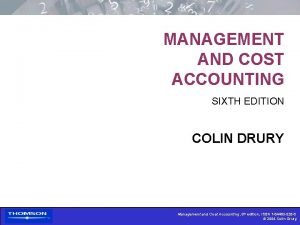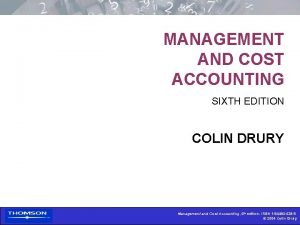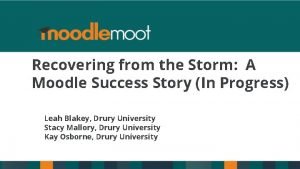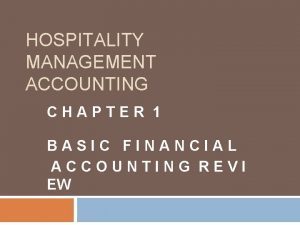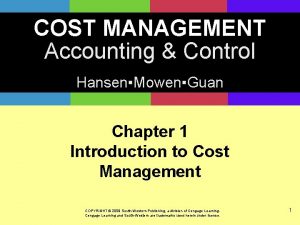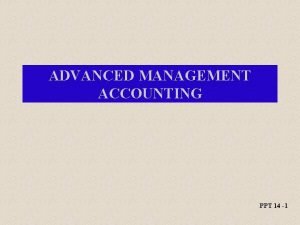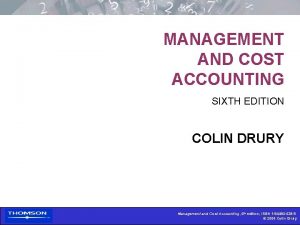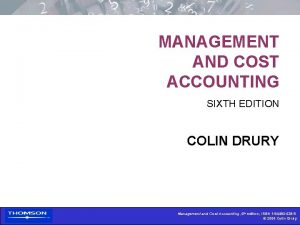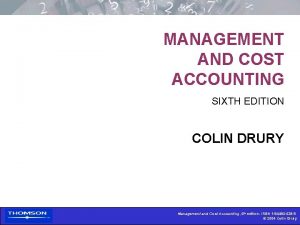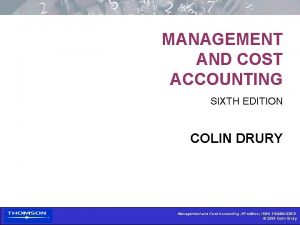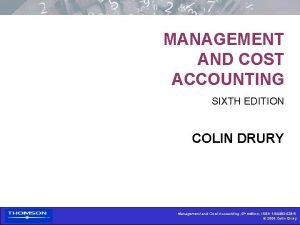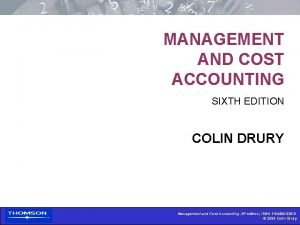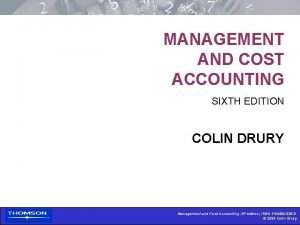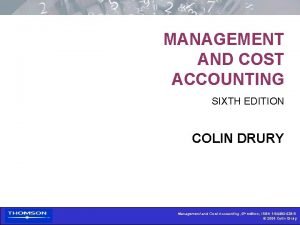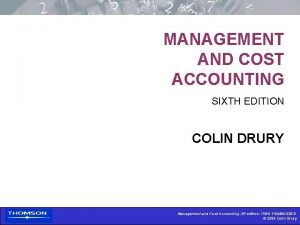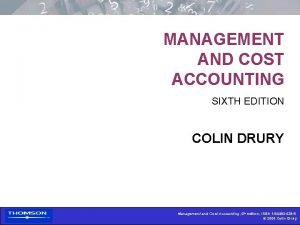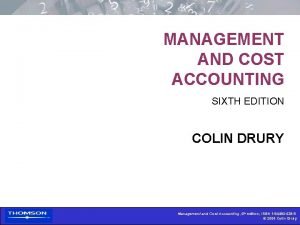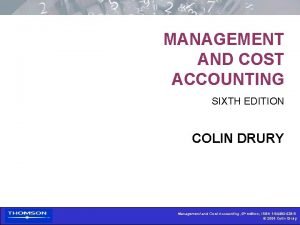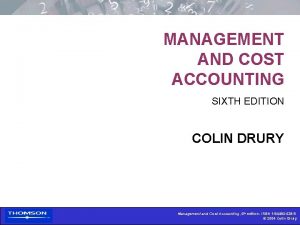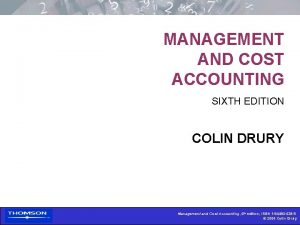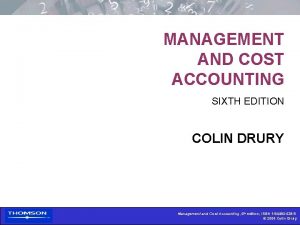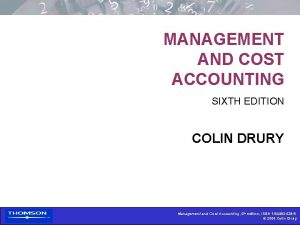MANAGEMENT AND COST ACCOUNTING SIXTH EDITION COLIN DRURY



















- Slides: 19

MANAGEMENT AND COST ACCOUNTING SIXTH EDITION COLIN DRURY Management and Cost Accounting, 6 th edition, ISBN 1 -84480 -028 -8 © 2004 Colin Drury

Part Four: Information for planning, control & performance Chapter Seventeen: Contingency theory and organizational and social aspects of management accounting Management and Cost Accounting, 6 th edition, ISBN 1 -84480 -028 -8 © 2000 Colin Drury © 2004 Colin Drury

17. 1 a Contingency theory approach • Advocates that there is no one best design of a management accounting control system (MACS) and that it all depends on the situational (contingent)factors. • The contingency theory literature has two strands — theoretical and empirical. Management and Cost Accounting, 6 th edition, ISBN 1 -84480 -028 -8 © 2000 Colin Drury © 2004 Colin Drury

17. 1 b Contingent factors can be grouped by major categories such as: 1. The external environment • Uncertain and certain • Static and dynamic • Simple and complex • Turbulent and calm 2. Competitive strategy and strategic mission • Low cost and differentiation • Defender and prospector • Product life cycle (Build, hold, harvest and divest) Management and Cost Accounting, 6 th edition, ISBN 1 -84480 -028 -8 © 2000 Colin Drury © 2004 Colin Drury

17. 1 c 3. Technology • Small batch, large batch, process production, mass production • Interdependence (pooled, sequential, reciprocal) 4. Business unit, firm and industry variables • Firm size • Firm diversification (single product, related diversified and unrelated diversified) • Organizational structure • Industry variables 5. Knowledge and observability factors • Knowledge of the transformation process • Outcome (output) observability • Behaviour (effort)observability Management and Cost Accounting, 6 th edition, ISBN 1 -84480 -028 -8 © 2000 Colin Drury © 2004 Colin Drury

17. 2 1. The external environment • Evidence to suggest that business units that face higher environmental uncertainty use a more subjective performance appraisal approach. • The greater the perceived environmental uncertainty the greater the need for more sophisticated accounting information that has a broad scope. Management and Cost Accounting, 6 th edition, ISBN 1 -84480 -028 -8 © 2000 Colin Drury © 2004 Colin Drury

17. 2 b 2. Competitive strategy and strategic mission • Advocated that defenders (Miles and Snow) and business units pursuing a low cost strategy (Porter) should adopt results measures that emphasize cost reductions and budget achievement. • Business units competing on the basis of differentiation (Porter) or those prospecting new markets should: 1. Have a more participative decision-making environment 2. Emphasize rewards based on non-financial factors (e. g. product innovation, market development) besides secondary financial measures. Management and Cost Accounting, 6 th edition, ISBN 1 -84480 -028 -8 © 2000 Colin Drury © 2004 Colin Drury

17. 2 c Evidence to suggest that: 1. Business units following a defender strategy place a greater emphasis on the use of financial measures for rewarding managers. 2. Non-financial measures for determining executives’ bonuses increases with the extent to which firms follow prospector strategies. 3. Businesses following a build strategy rely more on nonfinancial measures of performance for determining managers’ bonuses. Management and Cost Accounting, 6 th edition, ISBN 1 -84480 -028 -8 © 2000 Colin Drury © 2004 Colin Drury

17. 3 a 3. Firm technology and interdependence • The nature of the production process determines the type of costing system (Job or process costing). • Pooled, sequential and reciprocal interdependencies create the need for recharging costs to user centres. Management and Cost Accounting, 6 th edition, ISBN 1 -84480 -028 -8 © 2000 Colin Drury © 2004 Colin Drury

17. 3 b 4. Firm size, diversification, structure and industry type • Positive relationship between firm size and the sophistication of the management accounting system. • Related diversification: 1. Elaborate planning and budgeting systems to coordinate activities. 2. Rewards based on group performance • Unrelated diversification 1. Decentralization and the creation of profit and investment centres. 2. Greater reliance on financial results controls. • Structure — Interdependence that exists between responsibility centres determines style of budget evaluation. • Industry type influences type of control system employed. Management and Cost Accounting, 6 th edition, ISBN 1 -84480 -028 -8 © 2000 Colin Drury © 2004 Colin Drury

17. 4 a 5. Knowledge and observability factors Four areas examined: A. Knowledge of the transformation process and the ability to measure output. B. Appropriate type of performance assessment in relation to cause-and -effect relationships. C. Influence of programmability of decisions on the type of controls that should be used D. Relationship between accounting information and uncertainty about objectives and uncertainty about cause-and-effect relationships. Management and Cost Accounting, 6 th edition, ISBN 1 -84480 -028 -8 © 2000 Colin Drury © 2004 Colin Drury

17. 4 A. Knowledge of the transformation process and the ability to measure output (Source: Ouchi, 1979) • Above framework draws attention to those conditions where accounting-based control systems are inappropriate and places MACS within a broader framework of other organizational control systems. Management and Cost Accounting, 6 th edition, ISBN 1 -84480 -028 -8 © 2000 Colin Drury © 2004 Colin Drury

17. 5 a B. Appropriate type of performance assessment in relation to cause-and-effect relationships. Management and Cost Accounting, 6 th edition, ISBN 1 -84480 -028 -8 © 2000 Colin Drury © 2004 Colin Drury

17. 5 b Assessment situations and appropriate tests • Efficiency is concerned with achieving a given result with a minimum use of resources (or achieving maximum output from a given level of input resources). • Measures of effectiveness focus on whether or not the action resulted in the desired goal (i. e. Instrumental tests) Management and Cost Accounting, 6 th edition, ISBN 1 -84480 -028 -8 © 2000 Colin Drury © 2004 Colin Drury

17. 5 C. Influence of programmability of decisions on the type of controls that should be used • A programmed decision is one where the decision is sufficiently well understood for a reliable prediction of the decision outcome to be made: 1. Equivalent to cell 1 in the two previous diagrams 2. Behavioral and output controls are appropriate • A non-programmed decision is where one has to rely on the judgement of managers because there is no formal mechanism for predicting likely outcomes: 1. Equivalent to cells 2 and 4 in the two previous diagrams. Management and Cost Accounting, 6 th edition, ISBN 1 -84480 -028 -8 © 2000 Colin Drury © 2004 Colin Drury

17. 6 a D. Relationship between accounting information and uncertainty about objectives and uncertainty about cause-and-effect relationships Figure 17. 4 Uncertainty, decision-making and ideal information systems (Source: Earl and Hopwood, 1981) Management and Cost Accounting, 6 th edition, ISBN 1 -84480 -028 -8 © 2000 Colin Drury © 2004 Colin Drury

17. 6 b • Answer machines – AIS is used to provide solutions to problems (e. g. DCF, LP and EOQ models). • Dialogue machines – AIS is used to encourage exploration and debate rather than providing answers. • Learning machines – AIS is used to explore problems, ask questions, investigate the analysable parts of decisions and finally resort to judgement (e. g. sensitivity analysis). • Idea machines – AIS used to stimulate and trigger creativity. • Actual uses: – Ammunition machines used instead of dialogue machines (cell 2). – Answer machines used instead of learning machines (cell 3). – Rationalisation machines used instead of ideas machines (cell 4). Management and Cost Accounting, 6 th edition, ISBN 1 -84480 -028 -8 © 2000 Colin Drury © 2004 Colin Drury

17. 7 a Purposes of management accounting 1. A rational/instrumental purpose: • Assumes that the role of management accounting is to aid rational economic decision making. • This role is appropriate when task instrumentality is well understood and objectives are well understood. 2. A symbolic purpose: • Accounting information is used to signal to others inside and outside the organization that decisions are being taken rationally and that managers in the organization are accountable. • Managers can find value in AIS for symbolic purposes even when the information has little or no relation to decision-making. Management and Cost Accounting, 6 th edition, ISBN 1 -84480 -028 -8 © 2000 Colin Drury © 2004 Colin Drury

17. 7 b 3. A political/bargaining purpose: • Accounting information is used to achieve political power or a bargaining advantage. 4. A legitimating/retrospective rationalizing purpose: • Accounting information is used to justify and legitimise actions that have already been decided upon (i. e. endow past actions and decisions with legitimacy). 5. A repressive/dominating/ideological purpose: • Adopts a Marxist perspective and assumes that MAS play a crucial role in preserving capitalistic and class-based systems of domination. Management and Cost Accounting, 6 th edition, ISBN 1 -84480 -028 -8 © 2000 Colin Drury © 2004 Colin Drury
 Drury management and cost accounting
Drury management and cost accounting Drury c management and cost accounting
Drury c management and cost accounting Mmodation
Mmodation The sixth sick sheik's sixth sheep's sick lyrics
The sixth sick sheik's sixth sheep's sick lyrics Biochemistry sixth edition
Biochemistry sixth edition Qu moodle
Qu moodle Chris drury medicine wheel
Chris drury medicine wheel Craig drury
Craig drury Craig drury
Craig drury Computer architecture a quantitative approach sixth edition
Computer architecture a quantitative approach sixth edition Automotive technology principles diagnosis and service
Automotive technology principles diagnosis and service Automotive technology sixth edition
Automotive technology sixth edition Apa sixth edition
Apa sixth edition Computer architecture a quantitative approach 6th
Computer architecture a quantitative approach 6th Precalculus sixth edition
Precalculus sixth edition Principles of economics sixth edition
Principles of economics sixth edition Computer architecture a quantitative approach sixth edition
Computer architecture a quantitative approach sixth edition Materiality concept in accounting example
Materiality concept in accounting example Cost management accounting and control
Cost management accounting and control Non value added activities ppt
Non value added activities ppt
